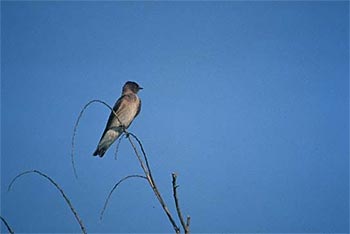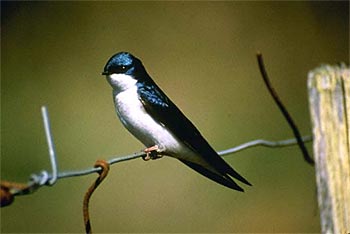| summer is over
Yesterday I stood on my back porch overlooking little Honeymoon Lake. The sun was going down. It was backlighting the insects buzzing around my backyard and over the lake. The lake was smooth and there were two Mallards paddling away from me. It was a most bucolic moment. And then I realized that which was not there. Two weeks ago the air had been full of wheeling and darting swallows gorging themselves on the insects. The occasional swallow would dive-bomb insects on the surface of the lake with a small splash and then rise and continue their nervous flight.
Swallows are my favorite birds to watch flying. They are the acrobats of the ariel world. Two weeks ago they would be everywhere as the sun went down. There is an alder in my back yard, at the edge of the lake. As if taking a break, Swallows would slowly gather in the tree and then, in unison, the would explode in all directions to continue their manic feeding.
Yesterday evening there was not a single one. I will miss them. They've been replaced by the mallards which are recently returned. The days get shorter, the evenings cooler, and the birds of summer leave and make way for the birds of winter.
One of the many projects that I have partially finished is noting the birds around Honeymoon Lake. I notice that it has been a year since I have mentioned my little bird buddies. Yesterday prompted me to honor these little suckers. The Mallards are easy to identify. Swallows are tricky. They don't hold still! Audubon had it easy. He would just shoot them. That made it easy for identification. Try looking for subtle differences in markings when the little son-of-a-bitches are just zooming by. I think there were two kinds of swallows this summer — Tree Swallows and Northern Rough-Winged Swallows.
Below are links to information about these birds. Pay particular attention to the write-ups by Audubon. They are a treat. (Adubon referred to the Tree Swallow as the White-bellied Swallow.)
The Northern Rough-Winged Swallow
Rough-Winged Swallow
by John James Audubon

On the afternoon of the 20th of October, 1819, I was walking along the shores of a forest-margined lake, a few miles from Bayou Sara, in pursuit of some Ibises, when I observed a flock of small Swallows bearing so great a resemblance to our common Sand Martin, that I at first paid little attention to them. The Ibises proving too wild to be approached, I relinquished the pursuit, and being fatigued by a long day's exertion, I leaned against a tree, and gazed on the Swallows, wishing that I could travel with as much ease and rapidity as they, and thus return to my family as readily as they could to their winter quarters. How it happened I cannot now recollect, but I thought of shooting some of them, perhaps to see how expert I might prove on other occasions. Off went a shot, and down came one of the birds, which my dog, brought to me between his lips. Another, a third, a fourth, and at last a fifth were procured. The ever-continuing desire of comparing one bird with another led me to take them up. I thought them rather large, and therefore placed them in my bag, and proceeded slowly towards the plantation of WILLIAM PERRY, Esq., with whom I had for a time taken up my residence.
[more]
Northern Rough-winged Swallow

[more]
NORTHERN ROUGH-WINGED SWALLOW
Northern Rough-winged Swallow
The Tree Swallow
The White-Bellied Swallow
by John James Audubon

This Swallow often spends the winter months in the State of Louisiana, resorting frequently to the neighbourhood of the marshes that border the lakes of Pont Chartrain and Bayou St. John, near the city of New Orleans, an account of which I have already given when speaking of the Republican Swallow. At the beginning of spring, it spreads widely over the country, and may be observed skimming over the streets of our cities, as well as along the meadows in their neighbourhood.
Its flight is easy, continued, and capable of being greatly protracted. It is seen sailing, circling, turning, and winding in all directions, during the greater part of the day. Like all other Swallows, it feeds on the wing, unceasingly pursuing insects of various kinds, and in seizing them producing a snapping noise, which may be heard at some distance. So quarrelsome is this Swallow, that it is almost continually fighting with its own species. Yet they remain in flocks at all seasons, and many pairs are often seen to breed within a short distance of each other. It also attacks the House Swallow, and frequently takes possession of its nest.
[more]
Tree Swallow

[more]
Tree Swallow
The Mallard Duck
The Mallard
by John James Audubon

ALTHOUGH it is commonly believed that the Mallard is found abundantly everywhere in the United States, I have received sufficient proof to the contrary. If authors had acknowledged that they state so on report, or had said that in the tame state the bird is common, I should not have blamed them. According to my observation, and I may be allowed to say that I have had good opportunities, this valuable species is extremely rare in the wild state in the neighbourhood of Boston in Massachusetts; and in this assertion, I am supported by my talented and amiable friend Mr. NUTTALL, who resided there for many years. Farther eastward, this bird is so rare that it is scarcely known, and not one was seen by myself or my party beyond Portland in Maine. On the western coast of Labrador none of the inhabitants that we conversed with had ever seen the Mallard, and in New-foundland the people were equally unacquainted with it, the species being in those countries replaced by the Black Duck, Anas fusca. From New York southward, the Mallards become more plentiful, and numbers of them are seen in the markets of Philadelphia, Baltimore, Richmond in Virginia, and other towns. Although they are very abundant in the Carolinas and Floridas, as well as in Lower Louisiana, they are much more so in the Western Country. The reason of this is merely that the Mallard, unlike the sea Ducks, is rarely seen on salt water, and that its course from the countries where it chiefly breeds is across the interior of the continent. From our great lakes, they spread along the streams, betake themselves to the ponds, wet meadows, submerged savannahs, and inland swamps, and are even found in the thick beech woods, in early autumn, and indeed long before the males have acquired the dark green colour of the head. Many of them proceed beyond the limits of the United States.
[more]
Mallard

[more]
Mallard
Mallard
Scolding MallardDecoy Shop
|

